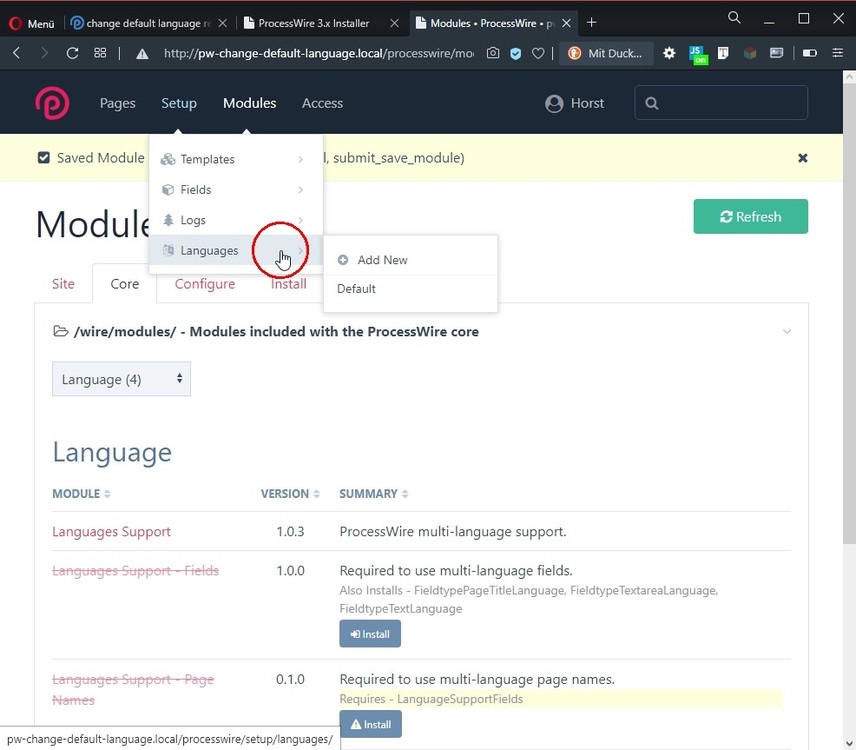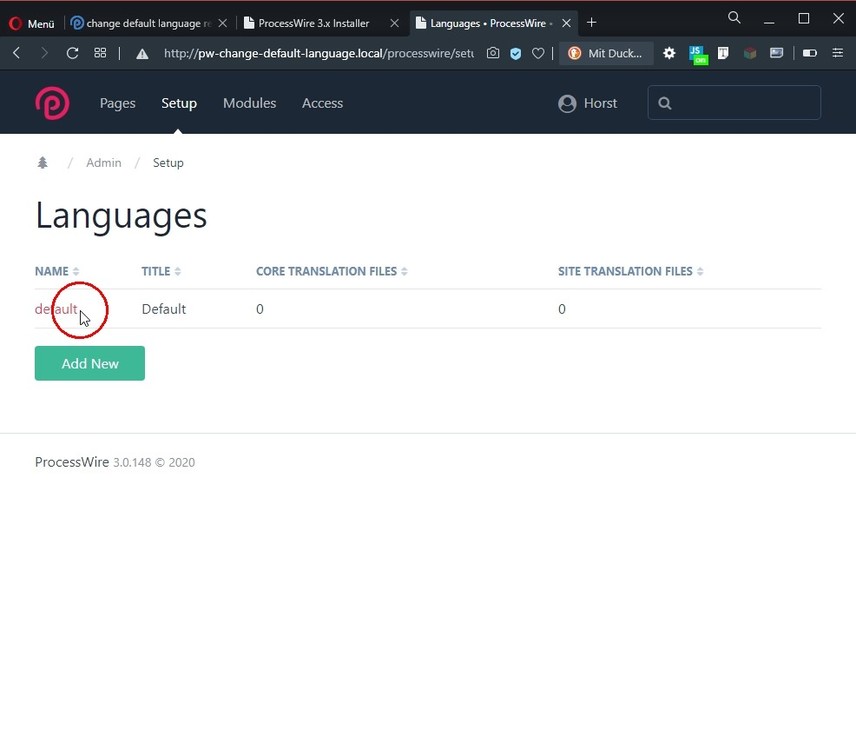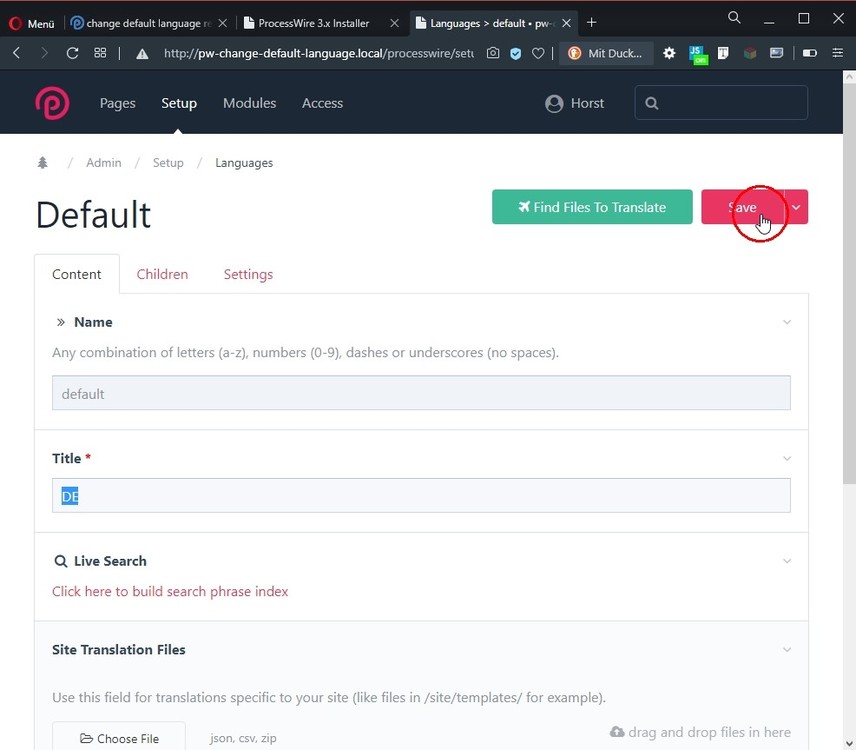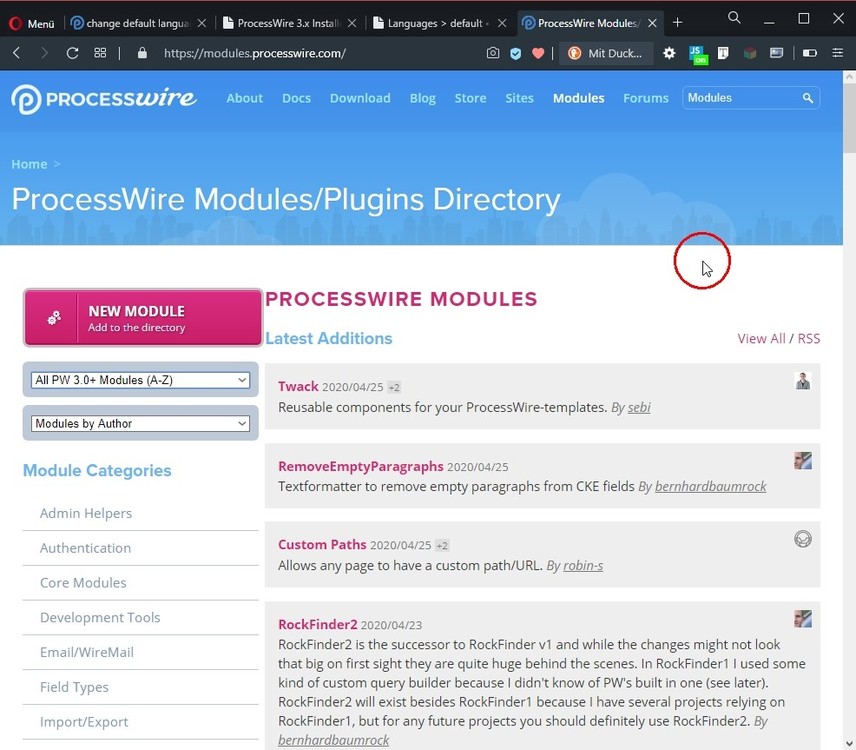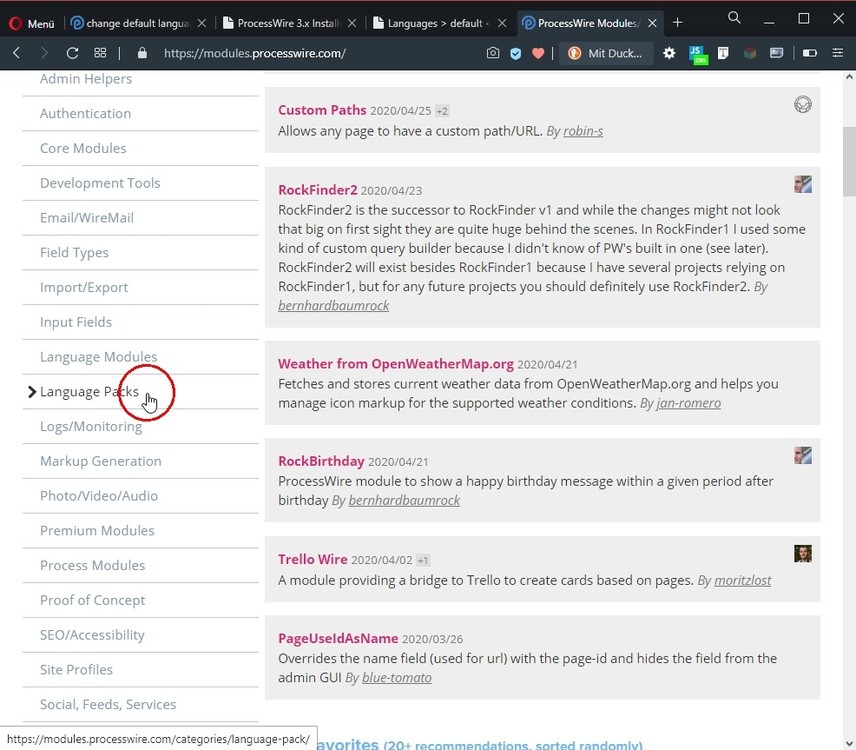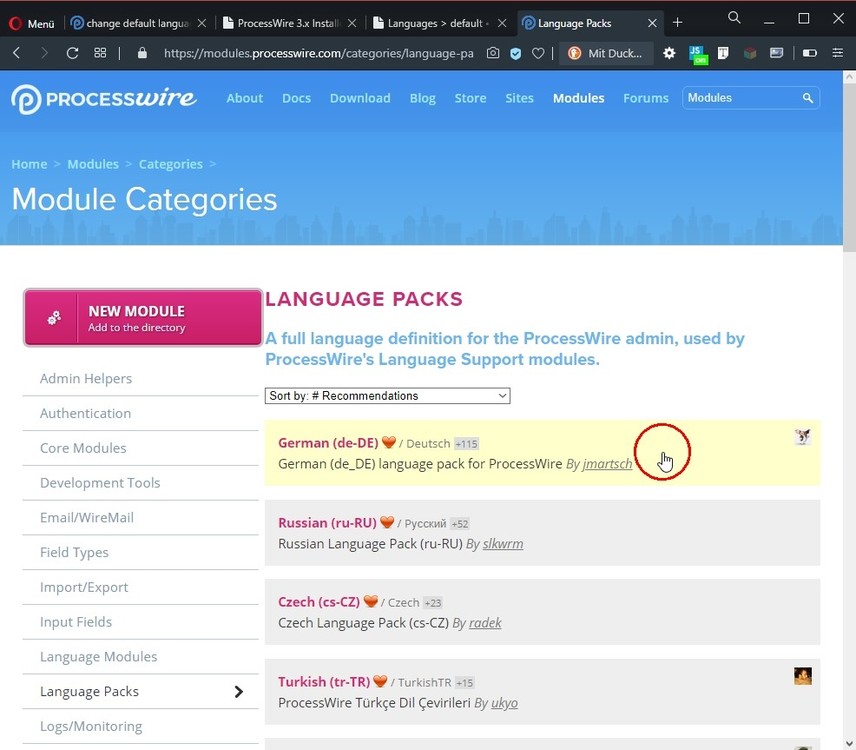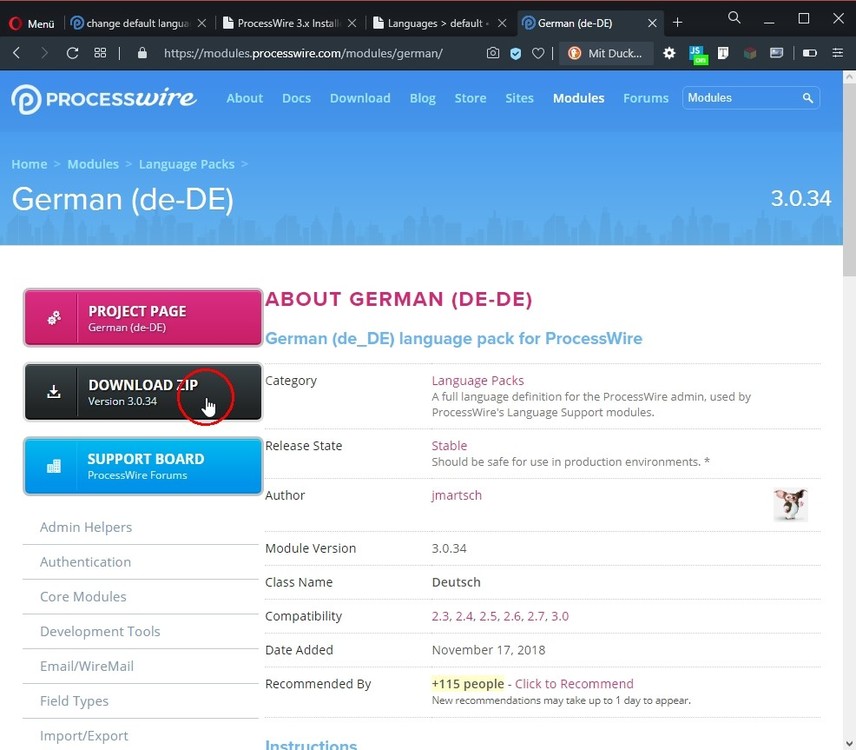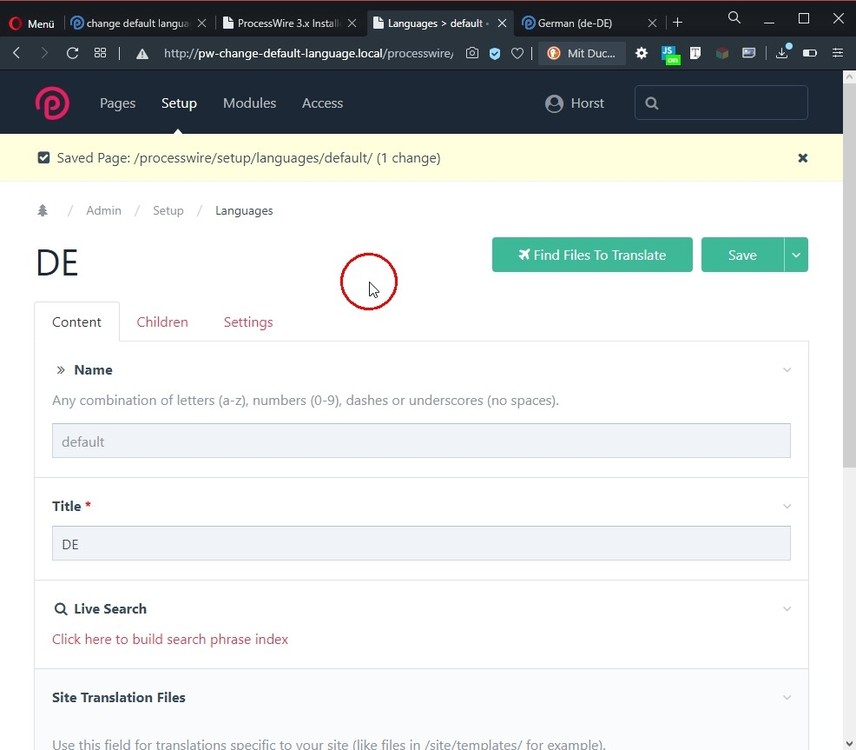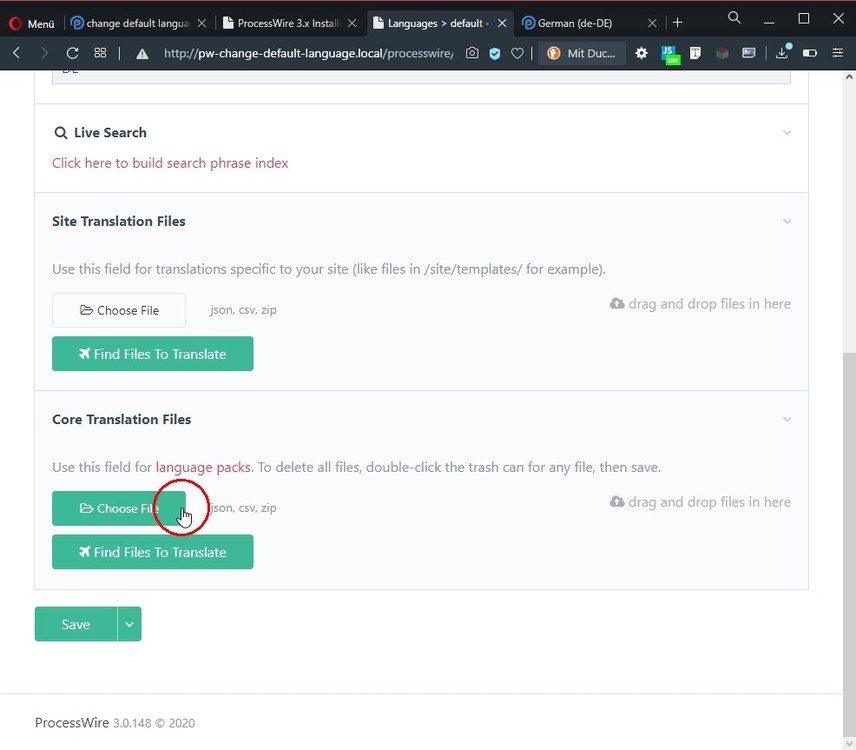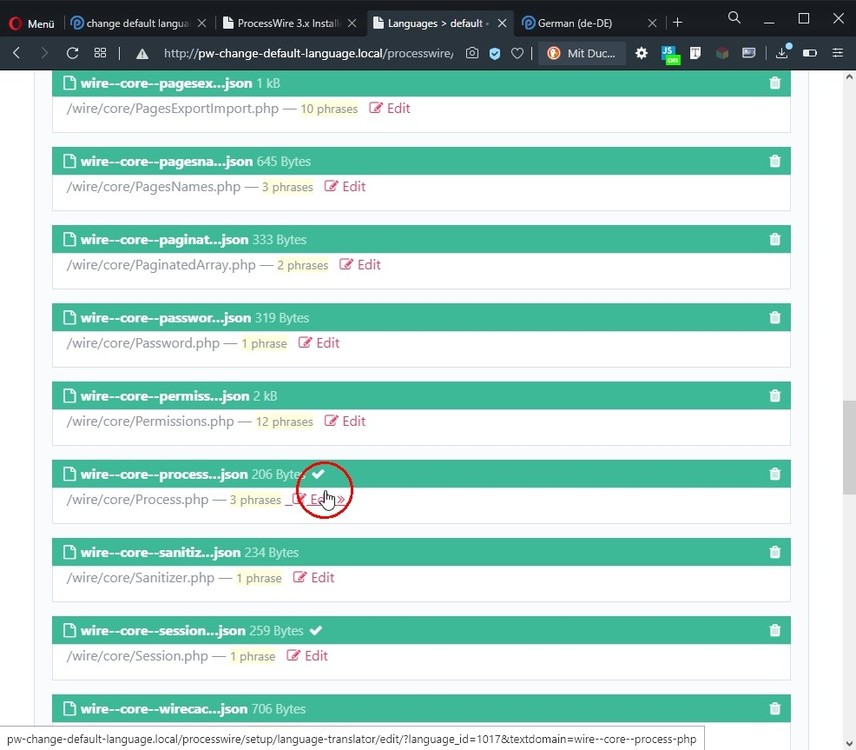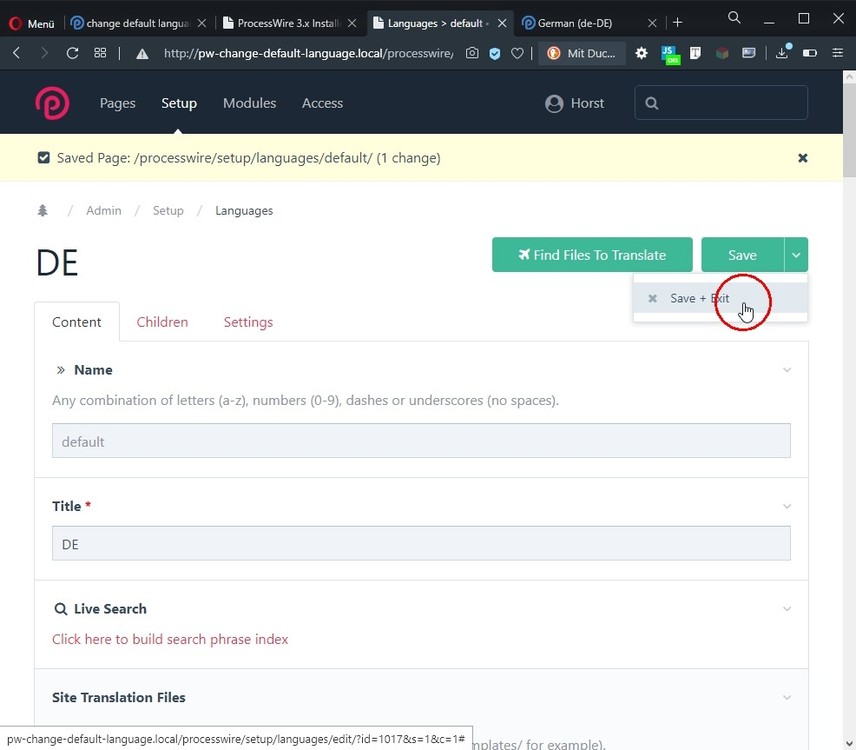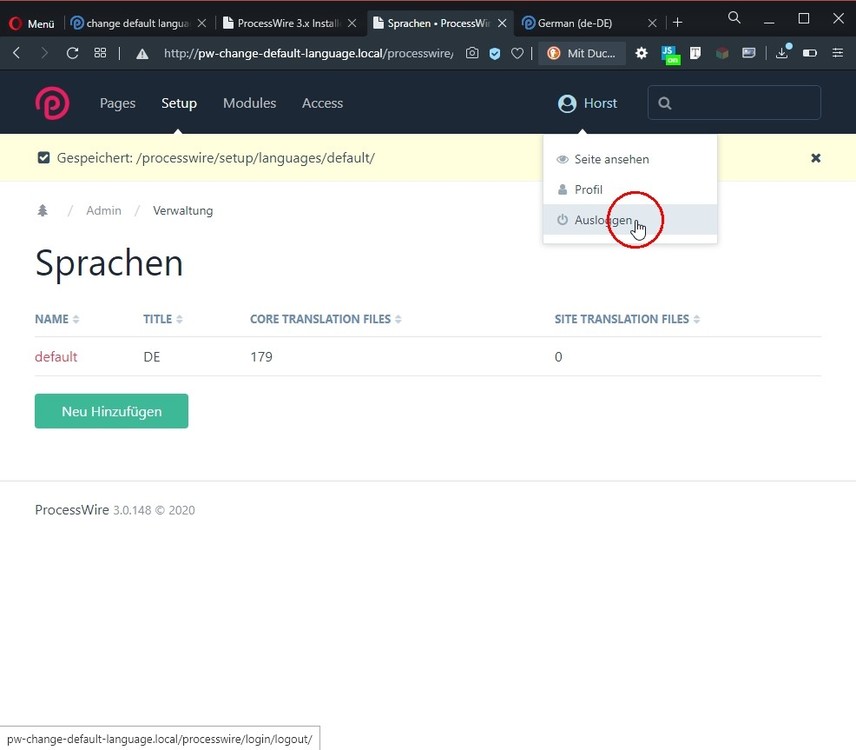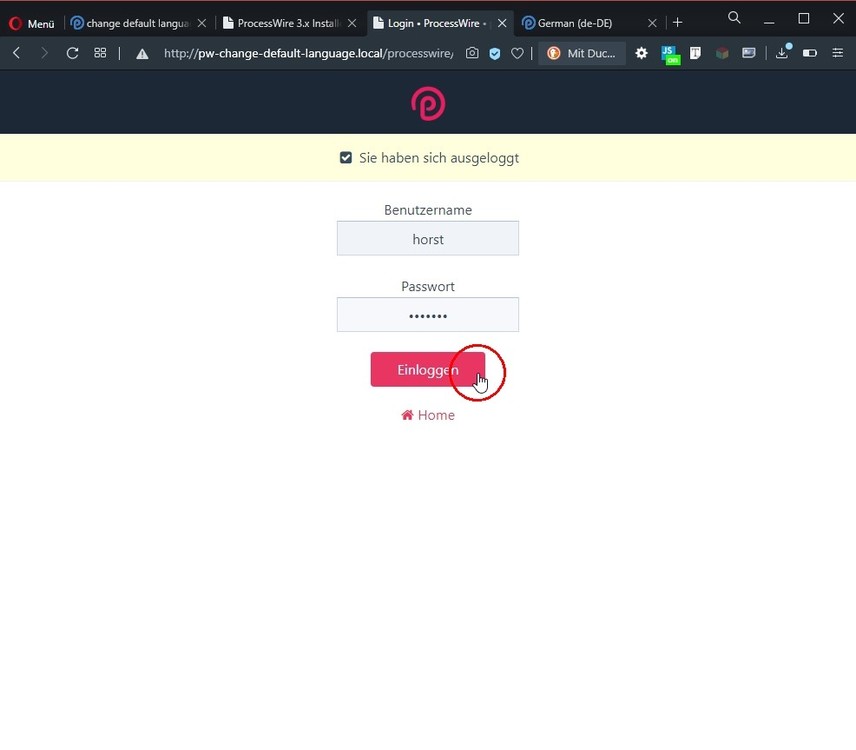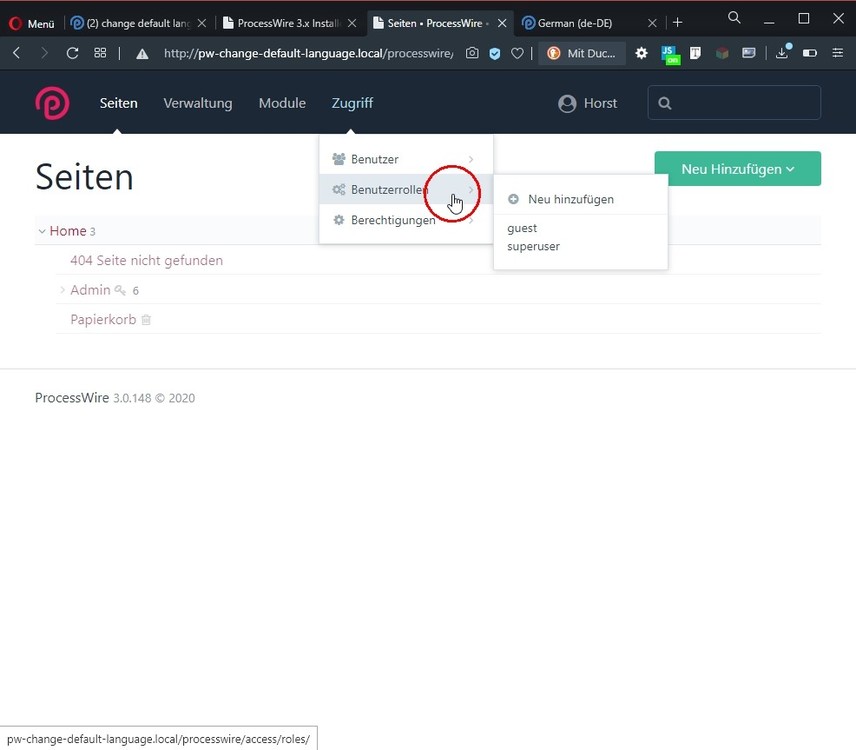Search the Community
Showing results for tags 'Language'.
-
I have 2 language, default and en. When i create a new page template "tag" i want the other language title to be copied on save. How do i hook this?
-
Hi community, I am using the "PageTable" Module (also called "ProFields: Page Table") and the built in "Language" Module (also called "Languages Support"). With the help of PageTable I was able to create several content elements which should usually be displayed in German(default language) and English. However some Content Elements should only be shown in German and NOT in English. Well sounds easy, right? Not so fast. I really love this CMS, but I have not found a solution for this problem yet. As you can see in the screenshots attached I tried to uncheck the "active" Checkbox for the english language to completely hide the content element for english users. However no matter what I do the german text shows on the english page. If I leave the "content-should-not-be-shown-in-english"(see Screenshot Number 2) blank and save the page, the page will inherit the german page url "content-element-with-simple-text-which-should-only-be-shown-in-german". My question therefore is: How can I hide a specific content-element for only one language? I´m using the latest processwire & module versions. The code which I use to render the content elements looks like this: //Info: contentelements is a field of type "ProFields: Page Table" <?php foreach ($page->contentelements as $element): echo($element->render()); endforeach; ?> filename: basic-page.php I would really appreciate your help since I haven´t found a solution after reading through quite a lot of forum posts. All the best, Dani
- 1 reply
-
- languagesupport
- pagetable
-
(and 1 more)
Tagged with:
-
I am struggling with an issue where my language switcher with flags sometimes doesn't show the flag. It works in the default language (german): but when the site is in english the german flag is not shown (path to image is not found): I don't really understand why it works if the site is shown in german but not in english.. Code for language switcher: // remember what language is set to $savedLanguage = $user->language; $languageImage = $savedLanguage->image->url; echo "<li><a href='#' class='dropdown-toggle' data-toggle='dropdown'><img src='$languageImage' alt='$savedLanguage->title'> <span uk-icon='icon: chevron-down'></span></a>"; echo "<div class='uk-navbar-dropdown'>"; echo " <ul class='uk-nav uk-navbar-dropdown-nav'>"; foreach($languages as $language) { //go through all languages // if user is already viewing the page in this language, skip it if($language->id == $savedLanguage->id) continue; // if this page isn't viewable (active) for the language, display root page $viewable = true; if(!$page->viewable($language)) $viewable = false; // set the user's language, so that the $page->url and any other // fields we access from it will be reflective of the $language $user->language = $language; // output a link to this page in the other language $path = $language->image->url; $pagePath = $page->url; if(!$viewable) $pagePath = $pages->get(1)->url; echo "<li><a class='uk-text-medium' href='$pagePath' alt='$language->title'><img src='$path' alt='$language->title flag'> $language->title</a></li>"; } echo " </ul>"; echo "</div>"; echo "</li>"; // restore the original language setting $user->language = $savedLanguage; Language template: image field is configured as automatic (array if multiple) in language page (both german and english) only one image is saved html output of language switcher dropwon (image couldn't be loaded): html output when image can be displayed:
-
Hello community! I want to share a new module I've been working on that I think could be a big boost for multi-language ProcessWire sites. Fluency is available in the ProcessWire Modules Directory and on Github Some background: I was looking for a way for our company website to be efficiently translated as working with human translators was pretty laborious and a lack of updating content created a divergence between languages. I, and several other devs here, have talked about translation integrations and have recognized the power that DeepL has. DeepL is an AI deep learning powered service that delivers translation quality beyond any automated service available. After access to the API was opened up to the US, I built Fluency, a third-party translation service integration for ProcessWire. Fluency brings automated translation to every multi-language field in the admin, and also provides a translation tool allowing the user to translate their text to any language without it being inside a template's field. With Fluency you can: Translate any plain textarea or text input Translate any TinyMCE or CKEditor (inline, or regular) Translate page names/URLs Translate in-template translation function wrapped strings Translate modules, both core and add-ons Installation and usage is completely plug and play. Whether you're building a new multi-language site, need to update a site to multi-language, or simply want to stop manually translating a site and make any language a one-click deal, it could not be easier to do it. Fluency works by having you match the languages configured in ProcessWire to those offered by the third party translation service you choose. Currently Fluency works with DeepL and Google Cloud Translation. Let's break out the screenshots... When the default language tab is shown, a message is displayed to let users know that translation is available. Clicking on each tab shows a link that says "Translate from English". Clicking it shows an animated overlay with the word "Translating..." cycling through each language and a light gradient shift. Have a CKEditor field? All good. Fluency will translate it and use DeepL's ability to translate text within HTML tags. CKEditor fields can be translated as easily and accurately as text/textarea fields. Repeaters and AJAX created fields also have translation enabled thanks to a JavaScript MutationObserver that searches for multi-language fields and adds translation as they're inserted into the DOM. If there's a multi-language field on the page, it will have translation added. Same goes for image description fields. Multi-language SEO friendly images are good to go. Creating a new page from one of your templates? Translate your title, and also translate your page name for native language URLs. (Not available for Russian, Chinese, or Japanese languages due to URL limitations). These can be changed in the "Settings" tab for any page as well so whether you're translating new pages or existing pages, you control the URLs everywhere. Language configuration pages are no different. Translate the names of your languages and search for both Site Translation Files (including all of your modules) Translate all of the static text in your templates as well. Notice that the placeholders are retained. DeepL is pretty good at recognizing and keeping non-translatable strings like that. If it is changed, it's easy to fix manually. Fluency adds a "Translate" item to the CMS header. When clicked this opens up a modal with a full translation tool that lets the user translate any language to any language. No need to leave the admin if you need to translate content from a secondary language back to the default ProcessWire language. There is also a button to get the current API usage statistics. DeepL account owners can set billing limitations via character count to control costs. This may help larger sites or sites being retrofitted keep an eye on their usage. Fluency can be used by users having roles given the fluency-translate permission. It couldn't be easier to add Fluency to your new or existing website. Simply add your API key and you're shown what languages are currently available for translation from/to as provided by DeepL. This list and all configuration options are taken live from the API so when DeepL releases new languages you can add them to your site without any work. No module updates, just an easy configuration. Just match the language you configured in ProcessWire to the DeepL language you want it to be associated with and you're done. Fluency also allows you to create a list of words/phrases that will not be translated which can prevent items such as brands and company names from being translated when they shouldn't Please note that the browser plugin for Grammarly conflicts with Fluency (as it does with many web applications). To address this issue it is recommended that you disable Grammarly when using Fluency, or open the admin to edit pages in a private window where Grammarly may not be loaded. This is a long-standing issue in the larger web development community and creating a workaround may not be possible. If you have insight as to how this may be solved please visit the Github page and file a bugfix ticket. Enhancements Translate All Fields On A Page Compatibility with newest rewrite of module is in progress... An exciting companion module has been written by @robert which extends the functionality of Fluency to translate all fields on a page at once. The module has several useful features that can make Fluency even more useful and can come in handy for translating existing content more quickly. I recommend reading his comments for details on how it works and input on best practices later in this thread. Get the module at the Github repo: https://github.com/robertweiss/ProcessTranslatePage Requirements: ProcessWire 3.0+ UIKit Admin Theme That's Fluency in a nutshell. A core effort in this module is to create it so that there is nothing DeepL related hard-coded in that would require updating it when DeepL offers new languages. I would like this to be a future-friendly module that doesn't require developer work to keep it up-to-date. The Module Is Free This is my first real module and I want to give it back to the community as thanks. This is the best CMS I've worked with (thank you Ryan & contributors) and a great community (thank you dear reader). DeepL Developer Accounts In addition to paid Pro Developer accounts, DeepL now offers no-cost free accounts. Now all ProcessWire developers and users can use Fluency at no cost. Learn more about free and paid accounts by visiting the DeepL website. Sign up for a Developer account, get an API key, and start using Fluency. Download & Feedback Download the latest version here https://github.com/SkyLundy/Fluency-Translation/archive/main.zip Github repository: https://github.com/SkyLundy/Fluency-Translation File issues and feature requests here (your feedback and testing is greatly appreciated): https://github.com/SkyLundy/Fluency-Translation/issues Thank you! ¡Gracias! Ich danke Ihnen! Merci! Obrigado! Grazie! Dank u wel! Dziękuję! Спасибо! ありがとうございます! 谢谢你!
- 189 replies
-
- 41
-

-

-
- translation
- language
-
(and 1 more)
Tagged with:
-
Hello @ all, I have created an inputfield with a configuration field in the backend where you can set a time format for every language (see screenshot below). As you can see both language values (default and German) have the default value(%R), but I have set different values, which were correctly stored in the DB (see screenshot below): As you can see the values are '%R' and '%r'. I have created the configuration inputfield like this: /** @var InputfieldText $f */ $languages = $this->wire('languages'); $f = $this->wire('modules')->get('InputfieldText'); $f->attr('name+id', 'timeformat'); $f->label = $this->_('Timeformat on frontend'); $f->initValue = '%R';//default value $f->attr('value', $this->timeformat ? $this->timeformat : '%R'); $this->message($this->get('timesformat')); if($languages) { $f->useLanguages = true; foreach($languages as $language) { if($language->isDefault()) continue; $f->set("value$language", (string) $this->get("timeformat$language->id")); } } $f->inputType = 'text'; $f->description = $this->_('Please enter the time format that the times should appear on the frontend in strftime format.'); $f->notes = sprintf($this->_('For example shows the time as 08:00, as 08:00 AM. You can find more examples at %s.'), '<a href="https://www.php.net/manual/de/function.strftime.php">https://www.php.net/manual/de/function.strftime.php</a>'); $f->columnWidth = 100; The important part here is: if($languages) { $f->useLanguages = true; foreach($languages as $language) { if($language->isDefault()) continue; $f->set("value$language", (string) $this->get("timeformat$language->id")); } } I have borrowed the code from the DateTimeInputfield (https://github.com/processwire/processwire/blob/master/wire/modules/Inputfield/InputfieldDatetime/InputfieldDatetime.module), but the field values will be always populated with the default value ('%R'). Are I am missing something? Does anyone has experience with multilanguage fields and could help me out? Thanks in advance.
-
Hello Till now I hacked something with the twig template but it works no more with new PW versions so I look forward to create a module. I am working on a site in multiple languages : French, English, Italian, German, Spanish, Portuguese, Hebrew, Russian. The new posts are entered in any language with a field for language. Till now, I got twig files to get the translations with constants defined for each part of the pages. So I'd like to create a module to include theses files added according to the url /fr/en/... Have you some observations to do before I begin about the direction to take ? Thank you
-
Change Default Language to be None-English | Walk Trough When you start a new (single) language site and the default language shouldn't be English, you can change it this way: Go to the modules core section: Select the Language ones by the filter function: We have four language related modules here, but for a single language site in none english, we only need the base module, named "Languages Support". So go on and install it. After that, you can leave it, ... ... and switch to the newly created Language section under SETUP: Select the default language Enter your new language name or its Shortcut and save the page. I will use DE for a single language site in german here as example: Now I go to the ProcessWire online modules directory, down to the subsection for language packs and select and download my desired (german) one: After downloading a lang pack as ZIP, I go back into my SETUP > LANGUAGES > default language page in admin, select the downloaded lang pack ZIP and install it: After the ZIP is uploaded, the files are extracted and installed, most of my screen is already in the new default language. To get all fully switched, we save and leave that page, ... ... and completely logout from the admin. Now, of course, we directly login back, ... ... and see, that now also the cached parts of the admin have switched to the new default language. ? That was it for a single language site in none english. If you want to have a multi language site, just add more languages to the SETUP > LANGUAGES section. When using a multi language site, I think you also want to use multi language input fields, and maybe different page names for your language page pendents. If so, you need to go into MODULES > CORE > filter LANGUAGE and install what you need or want to use of it, (if not already done). Thanks for reading and happy coding, ?
- 14 replies
-
- 21
-

-

-
- tutorial
- default language
-
(and 4 more)
Tagged with:
-
Hi ? Anyone else having this problem? Requirements: - Repeater (matrix & normal) with mutlilanguage fields (text, textarea…) - Backend language set to something other than default (ie. German) Reproduce: - Add a new repeater Item (ajax, I found no way to possible to disable it with matrix) (Notice how the default language tab is active instead of the backend language…) - Write something into the (default language) field - Try to save, if field is required, this will not work. If not required, then when reloading, the content will be inside the backend language field, instead of the default language field who was (presumably) active Analysis: When loading a new repeater element with ajax, the default langue tab is active, but the backend language inputfield is visible (with no visual indication). When writing into the field, it will populate the backend language. When manually clicking on the default language tab (which is already active), the field will switch to the actual default language field (which is [now] empty) (that can now be populated…) Also Notice, the labels of the elements to be added are in default language as well instead of the translated label (images instead of Bilder)… ProcessWire 3.0.148, Profields 0.0.5… Is it my system configuration, or does anyone else have the same issue? This is a screen recording of the problem: Issue: https://github.com/processwire/processwire-issues/issues/1179 Screen Recording 2020-02-25 at 14.18.31.mov
-
Hopefully this is the right place, if not, please move it to the proper sub. I installed the multi language module on my development (sandbox) set up not too long ago to test out a few things. From the start, I ran into some issues with dependencies not being met/installed, so I thought that I would simply just uninstall what had been. Unfortunately, that took me down a road of using some code in my home template to remove the modules (cant find it at the moment). After some struggling, I finally got it uninstalled, but it left behind 3 fields, language language_files language_files_site I thought that I could simply remove them from the languages template and then delete them, but I get the following error: I was wondering, is there a way to remove these using the api? I couldn't add any new users to the setup until I made "language" not required, but I was hoping to just remove all of the fields.
-
"Deepl" is an unbelievably good (paid) text translation service, that mops the floor with Google Translate. They have an API and it would be awesome, if there would be a module, that would integrate it for easy content translation. It could be a right-click context menu on the language tab: It should ask from which of available other language it shall take translate from. What do you think?
-
Hello, I'm very new to ProcessWire but already fell in love with this CMS/CMF! I just finished my first small project and as I saw a lot of questions and different answers in this forum on how to set up a nice language switcher for your website, I decided to write my first tutorial. ---------- Please note: I rewrote this tutorial since I was made aware and learned that flags should not be used for language selectors! There are some threads here in the forum (and from external sources) where this question is discussed: https://processwire.com/talk/topic/13196-adding-image-field-to-language/ http://daily.unitedlanguagegroup.com/stories/editorials/inside-design-language-selector-no-flags https://processwire.com/talk/topic/16524-extending-languages-template/ http://www.flagsarenotlanguages.com/blog/why-flags-do-not-represent-language/ https://processwire.com/talk/topic/14241-language-names-and-utf8-page-names/ Thanks, @ottogal @bernhard @jmartsch @kongondo an all others for your hints! ---------- TUTORIAL - Set up a nice language switcher for your website - here we go: This will be the desired result! Step 1) Setup at least 2 languages in your PW install. In my case it's German (default language) + English: Step 2) Add a custom field Type = Text Name = languagecode This will hold the ISO 639-1 two-letter language code for the respective language. The field is needed to provide a simple method for outputting the language code in your templates. Without this field, you will need to programmatically construct your two-letter language code output via PHP (at least for the default language, as ProcessWire doesn't allow to rename the default language and it will always be called default). Here is an overview for ISO 639-1 two-letter language codes: https://en.wikipedia.org/wiki/List_of_ISO_639-1_codes Step 3) Add this field to the system template: language. To achieve this, go to Setup / Templates and activate the filter Show system templates: Now you can add the previously created field languagecode to the language template. Step 4) Edit your languages and fill in the appropriate values. a) default (German) Name = default (this can't be changed and is read only) Title = Deutsch (in both language tabs! - this is important as your visitor should always see his language item ... in his language) languagecode = de b) english (English) Name = english Title = English (in both language tabs! - this is important as your visitor should always see his language item ... in his language) languagecode = en Step 5) Now we are ready to write our template output! As we already have the appropriate two-letter ISO language code (languagecode field), we can use this in our html lang property: <html lang="<?php echo $user->language->languagecode; ?>"> Also the rel alternate output in the html head is simple. Put the following code within your <head></head> area: <?php // Handle output of 'hreflang' link tags for multi-language (SEO!) foreach ($languages as $language) { if (!$page->viewable($language)) { continue; } // Get the http URL for this page in the given language $url = $page->localHttpUrl($language); // Get the language code using custom languagecode field $languagecode = $language->languagecode; echo PHP_EOL.'<link rel="alternate" hreflang="'.$languagecode.'" href="'.$url.'">'; } ?> In my sample I've used Boostrap 4 and the code below shows a complete navbar with our language switcher (BTW the language switcher will always be visible, even when the bootstrap navbar is collapsed): <nav id="mainnav" class="navbar navbar-expand-lg navbar-light px-4 px-md-5 sticky-top"> <a class="navbar-brand" href="<?php echo $config->urls->root; ?>"> <img src="<?php echo $config->urls->templates; ?>images/logo-rund-80x80.png" alt=""> Your Site Title </a> <ul class="navbar-nav ml-auto mr-3 mr-lg-0 order-lg-last d-none d-xs-custom-flex language-switcher" aria-label="<?php echo __('Sprache wechseln') ?>"> <?php echo '<li class="nav-item dropdown">'; // Construct the language prompt in the current user language $prompt = $user->language->title.' ('.strtoupper($user->language->languagecode).')'; // Current language = dropdown-toggle echo '<a class="nav-link dropdown-toggle" href="#languages" id="language-select" data-toggle="dropdown" aria-haspopup="true" aria-expanded="false">'; echo '<span class="world-icon"></span><span class="sr-only">'._x('(aktuelle Sprache)', 'navigation').': </span> '.$prompt; echo '</a>'; echo '<div id="languages" class="dropdown-menu dropdown-menu-right" aria-labelledby="language-select">'; foreach ($languages as $language) { // Get the http URL for current page in the given language $url = $page->localHttpUrl($language); // Construct the language prompt in the given language $prompt = $language->title.' ('.strtoupper($language->languagecode).')'; // Next language item (except current language) if ($user->language->id != $language->id) { if (!$page->viewable($language)) { echo '<span class="dropdown-item disabled">'.$prompt.'</span>'; } else { echo '<a class="dropdown-item" href="'.$url.'">'.$prompt.'</a>'; } } } echo '</div>'; echo '</li>'; ?> </ul> <button class="navbar-toggler" type="button" data-toggle="collapse" data-target="#navbarMainMenu" aria-controls="navbarMainMenu" aria-expanded="false" aria-label="<?php echo __('Menü einblenden / ausblenden') ?>"> <span class="navbar-toggler-icon"></span> </button> <div class="collapse navbar-collapse my-3 my-lg-0" id="navbarMainMenu"> <ul class="navbar-nav mr-auto"> <?php // Top navigation consists of homepage and its visible children foreach ($homepage->and($homepage->children("template=main-page|news|contact-points")) as $item) { if ($item->id == $page->rootParent->id) { echo '<li class="nav-item active">'; echo '<a class="nav-link" href="'.$item->url.'">'.$item->title.'<span class="sr-only"> '._x('(aktuelle Seite)', 'navigation').'</span></a>'; echo '</li>'; } else { echo '<li class="nav-item">'; echo '<a class="nav-link" href="'.$item->url.'">'.$item->title.'</a>'; echo '</li>'; } } ?> </ul> </div> </nav> That's it! I hope you will like my tutorial and if there are any questions, critics or improvements please let me know! Thanks, Martin
-
Hello! After I upgraded PW from 2.5.? to 3.0.116, my language tabs in the backend behave strange. I have 3 languages: german, french and english (default). Since I upgraded, all multilingual fields show the 3 tabs (DE, FR, EN) plus an additional textfield below for EN (see screenshots). The german tab is ok, but the upper tabs FR and EN both show the content in french, while the additional tab below shows the english content. When I click on the folder icon to the right to change the view, all looks ok. Also the frontend is ok. I uninstalled and reinstalled the module «LanguageTabs», but that didn't help … Any ideas? Thanks a lot, Andrej
-
Hi all, Thought I had the language translation working but now when I attempt to access the language through the backend (Setup > Languages > My Language) it throws an error: Recoverable Fatal Error: Argument 3 passed to ProcessWire\LanguageTranslator::textdomainTemplate() must be of the type array, null given Can anybody shed any light on what would cause this error when trying to access my language through the settings in the backend, or attempting to view it on the frontend with its language specific URL. The only thing I have changed recently was moving the DB to a different location however the one exported was the one that I previoulsy had my custom language working on it previoulsy. Any ideas, im at a bit of a lose as to what would have caused this when it was working previously.
-
JSON files is bad. Need a convenient method of translation.
-
datetime DateTime format according to user language
Eunico Cornelius posted a topic in API & Templates
Hi, I am new to process wire and I've been trying to change the date time format in my webpage according to its language selection(example: English 'd/m/y' , Deutsch: 'd.m.y'). I know that using $datetime->getDateFormats(); we can achieve the type of formats in the shape of indexes. Also, by using $user->language->id we can know which language we are using. How do I combine this two functions so that when I select English/Deutsch, the date will be adjusted accordingly? Is there a specific function that can do this or is there any provided index in the $user->language somewhere. Thanks in advance :). -
Does anyone here have experience installing a translation module that creates new pages for multiple languages? I am assuming when these pages are generated, they are indexable by google as "new" and "fresh." Thoughts?
-
Hello, I am just working on a multi-language pw app. Default language is german, then comes english. the language segment for english in the url is 'en-home' , eg. '../en-home/products', I think this was taken as a default option. (this happened several months ago, so I do not remember exactly...). Now I want to change this segment simply to 'en'. However, in 'Pages...Settings', only the part AFTER 'en-home' is editable, so I do not see any possibility to change this segment. Neither do the Languages Settings offer such a possibility ;-(( Or do I miss something?
-
How can I upload files without changing the original filenames? I use processwire in English and Japanese. When I upload a file, the filename is sanitized and changed to an alphanumeric name. I need some files to be uploaded with original filenames with Japanese characters (2-byte characters). Is there a good way to do this? Thanks in advance, Yu
-
I was trying to fix an error earlier which was preventing a series of if statements from working. Basically I have a button called "Product Drawing" which needs localising depending on the current language session. Eventually got it working - I had a bracket in the wrong place. Curious as to why both these work though. On the sample below. each echo is surrounded by curly braces. <?php if ($page->files->count()) foreach($page->files->findTag('drawing') as $file) { if($user->language->name == 'default') {echo "<a href='$file->url' class='uk-button uk-button-primary'>Product drawing</a>";} if($user->language->name == 'french') {echo "<a href='$file->url' class='uk-button uk-button-primary'>Le plan du produit</a>";} if($user->language->name == 'german') {echo "<a href='$file->url' class='uk-button uk-button-primary'>Produktzeichnung</a>";} if($user->language->name == 'spanish') {echo "<a href='$file->url' class='uk-button uk-button-primary'>El dibujo del producto</a>";} if($user->language->name == 'italian') {echo "<a href='$file->url' class='uk-button uk-button-primary'>Il disegno del prodotto</a>";} } ?> On the sample below, there are no curly braces around the echo <?php if ($page->files->count()) foreach($page->files->findTag('breakingreport') as $file) { if($user->language->name == 'default') echo "<a href='$file->url' class='uk-button uk-button-primary'>Breaking strain report</a>"; if($user->language->name == 'french') echo "<a href='$file->url' class='uk-button uk-button-primary'>Le test de rupture</a>"; if($user->language->name == 'german') echo "<a href='$file->url' class='uk-button uk-button-primary'>Bruchfestigkeit bericht</a>"; if($user->language->name == 'spanish') echo "<a href='$file->url' class='uk-button uk-button-primary'>Informe resistencia</a>"; if($user->language->name == 'italian') echo "<a href='$file->url' class='uk-button uk-button-primary'>La rottura rapporto ceppo</a>"; } ?> Should the second piece work?
- 15 replies
-
Hey there, I'm very new to Processwire but allready in love! So far my experience was great but I ran into an internal server Error (500) and my error logfile logged: Error: Exception: Unknown language (in P:\xampp\htdocs\xxx\wire\modules\LanguageSupport\Languages.php line 343) (I know XAMPP is not the best developing area but for simplicity reasons I like it...) The line 343 in my Languages.php(unchanged by me) is: if(!$language instanceof Language || !$language->id) throw new WireException("Unknown language"); in the function of public function setLanguage($language) { if(is_int($language)) { $language = $this->get($language); } else if(is_string($language)) { $language = $this->get($this->wire('sanitizer')->pageNameUTF8($language)); } if(!$language instanceof Language || !$language->id) throw new WireException("Unknown language"); $user = $this->wire('user'); $this->savedLanguage2 = null; if($user->language && $user->language->id) { if($language->id == $user->language->id) return false; // no change necessary $this->savedLanguage2 = $user->language; } $user->language = $language; return true; } I have no clue what the problem is and as far as I know when I closed the website the day before everything was working just fine. I copied the whole folder to "develop" further on my laptop. The next day I got the error mentioned above when requesting the site. (On the original and the copy) Any suggestions what I should do?
-
I have to languages - english and russian. I need russian language to be set as default for admin panel. How to do it? Thanks!
-
I would like to be able to fetch the labels for fields in a language different than the current logged in user. For field values that's easy // p is page, l is language, and f is field $p->getLanguageValue($l, $f); I'm looking for something like $fields->getLanguageValue('en', 'length'); The only solution I know of is to save the current user language, iterate through the languages by setting the user language and fetching the value, and then restore the user language.
-
Started my first demo multilingual site last night and I'm really pleased with the ease of setup. I had a 1 page demo with 5 languages and a language switcher and menu running relatively quickly. Before I get too far down the road, I thought I'd ask some of you more experienced multilingual devs what I should be aware of? Off the top of my head... Do any multi-lingual SEO modules exist or should I build my own fields here? I normally use MarkupSEO but not sure yet if it supports multi-lingual. Are any of the Pro fields NOT multilingual? I'm using a single tree with language options as tabs on each field. Is this a better method than having a separate tree for each language? Are image Description fields multilingual? Anything else I should be aware of? For example I read recently that web forms using FormBuilder should be built separately for each language. That's not a huge deal but a good example of something I hadn't anticipated. Cheers P
-
Hi there I want to render a page in a particular language, somehow like $page->render('de'). How can I achieve that? Some background information to my problem: I wrote a module that generates HTML newsletter emails. From the PW backend I use that module to send emails, which are represented by pages that are rendered and sent off. Now I want to control the email language. The email shouldn't be just rendered in the language of my backend user account, of course. Any help is much appreciated. Best, Daniel
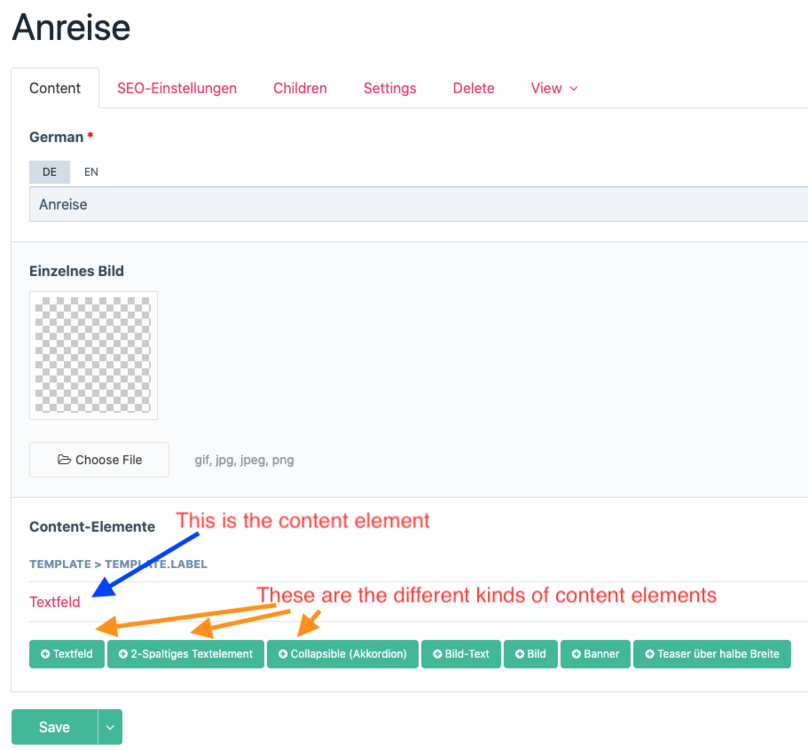
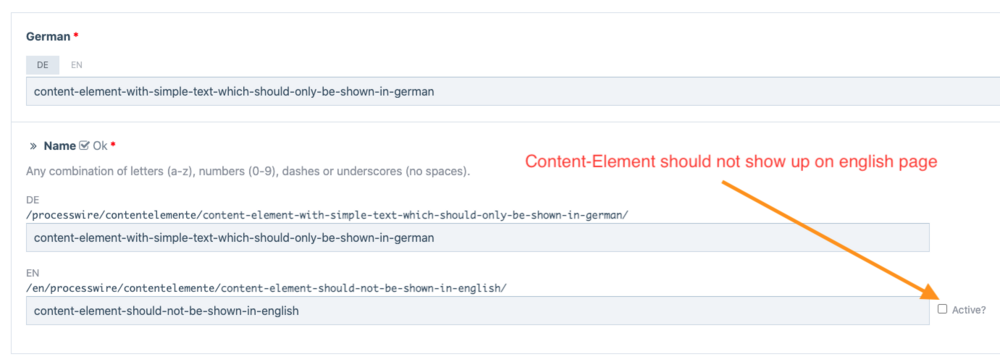


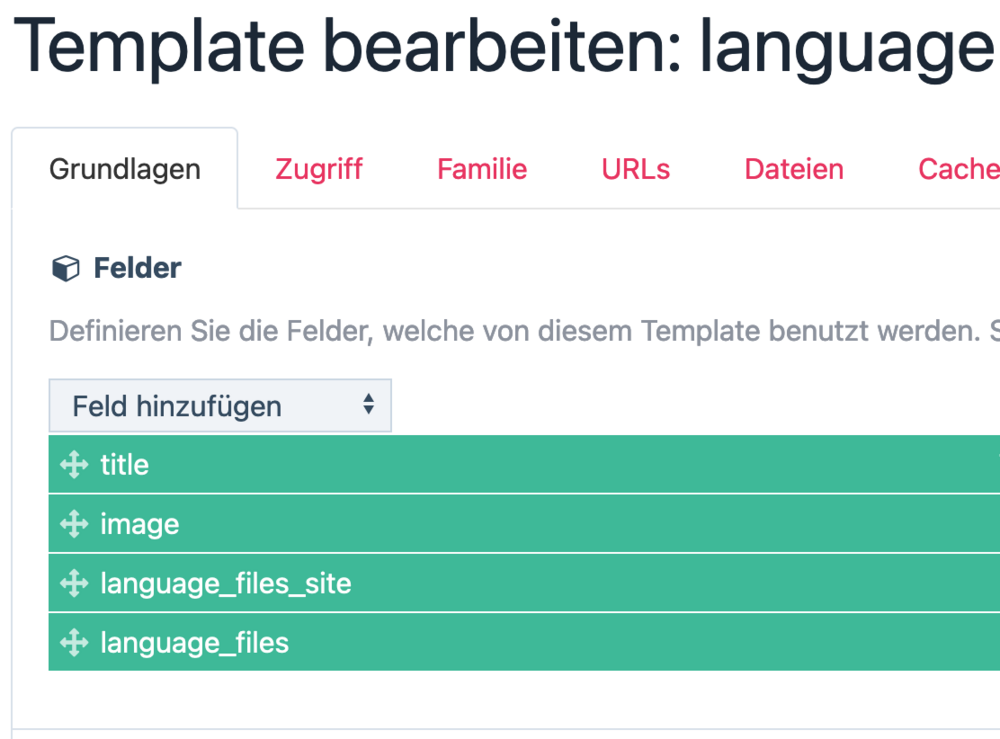















.thumb.png.f36b46f820f4e21117c5a19a3bff62d8.png)
.thumb.png.f5c7fd94d87bf333611153c5b60b1cc1.png)





